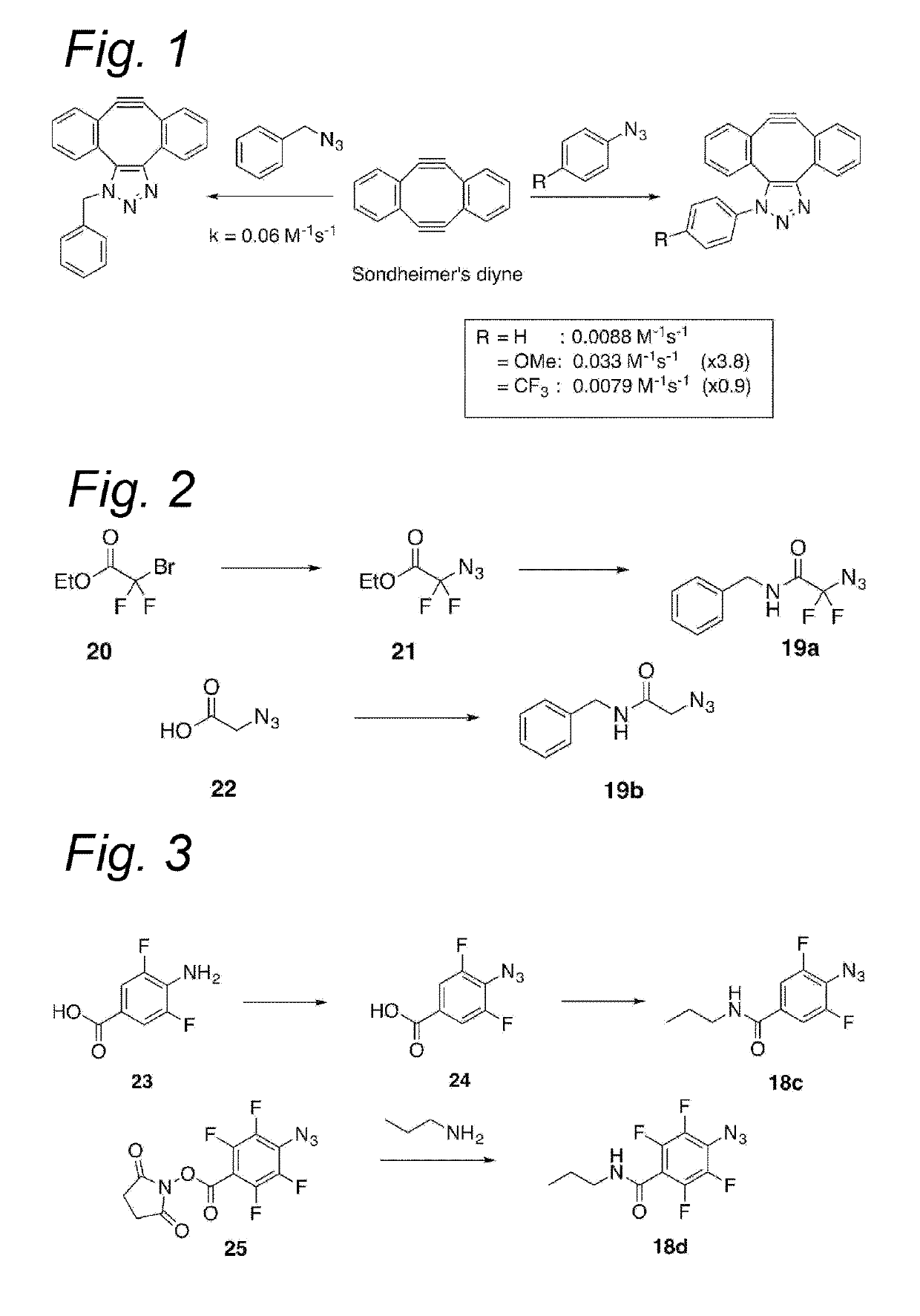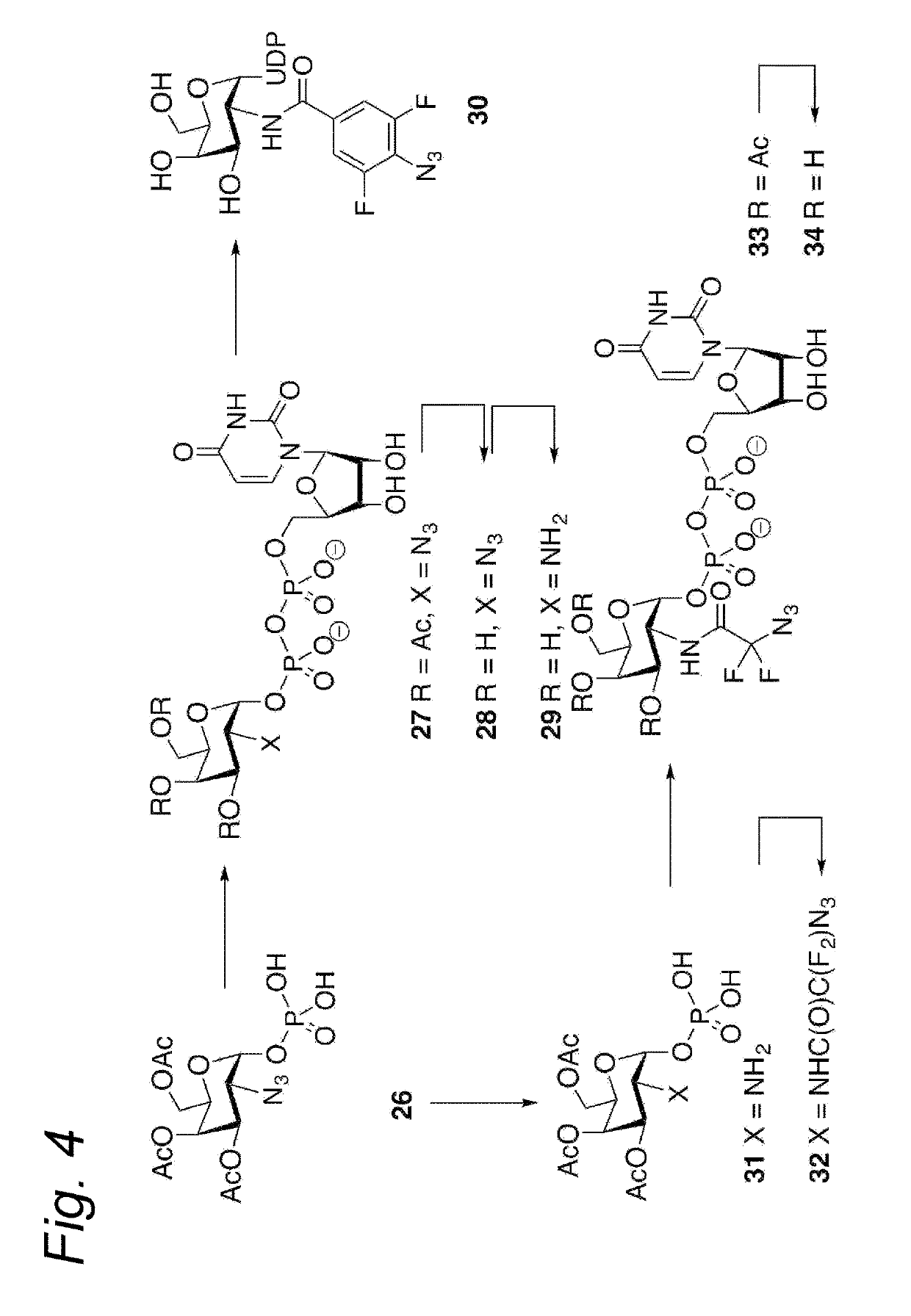Process for the cycloaddition of a halogenated 1,3-dipole compound with a (hetero)cycloalkyne
a cycloalkyne, halogenated technology, applied in the preparation of sugar derivatives, esterified saccharide compounds, sugar derivatives, etc., can solve the problems of low reaction rate, and low reaction rate of plain cyclooctyne with azid
- Summary
- Abstract
- Description
- Claims
- Application Information
AI Technical Summary
Problems solved by technology
Method used
Image
Examples
example 1
of ethyl 2-azido-2,2-difluoroacetate (21)
[0330]To a solution of ethyl 2-bromo-2,2-difluoroacetate (20) (950 mg, 4.68 mmol) in dry DMSO (5 mL) was added sodium azide (365 mg, 5.62 mmol). After stirring overnight at room temperature, the reaction mixture was poured out into water (150 mL). The layers were separated, dichloromethane was added to the organic layer and the layer was dried over sodium sulfate (Na2SO4). After filtration, the solvent was removed under reduced pressure (300 mbar) at 35° C. affording the crude product 21 (250 mg, 1.51 mmol, 32%).
[0331]1H-NMR (300 MHz, CDCl3): δ 4.41 (q, J=7.2 Hz, 2H), 1.38 (t, J=6.9 Hz, 3H).
example 1-1
f ethyl 3-azido-3,3-difluoropropanoate
[0332]To a solution of ethyl 3-bromo-3,3-difluoropropanoate (260 mg, 1.20 mmol) in acetone (1.2 mL) was added sodium azide (117 mg, 1.797 mmol) and the resulting suspension was stirred overnight at r.t. The reaction mixture was diluted with H2O (3 mL) and extracted with DCM (3×15 mL). The combined organic layers were dried over sodium sulfate, filtered and the solvent was removed under reduced pressure (500 mbar) to afford crude ethyl 3-azido-3,3-difluoropropanoate (174 mg, 0.97 mmol, 81%).
[0333]1H-NMR (400 MHz, CDCl3): δ 4.24 (q, J=7.2 Hz, 2H), 3.04 (t, J=11.2 Hz, 2H), 1.30 (t, =7.2 Hz, 3H).
example 2
of 2-azido-N-benzyl-2,2-difluoroacetamide (19a)
[0334]Ethyl 2-azido-2,2-difluoroacetate (2l) (48 mg, 0.291 mmol) was dissolved in dichloromethane (4 mL) and benzylamine (32 μL, 0.291 mmol) and Et3N (60 μL, 0.436 mmol) were added. The reaction was allowed to stir overnight and the solvent was removed under reduced pressure. Flash chromatography (15:1 pentane:EtOAc) afforded the product 19a.
[0335]1H-NMR (300 MHz, CDCl3): δ 7.40-7.25 (m, 5H), 4.50 (d, J=5.7 Hz, 2H).
PUM
| Property | Measurement | Unit |
|---|---|---|
| temperature | aaaaa | aaaaa |
| temperature | aaaaa | aaaaa |
| temperature | aaaaa | aaaaa |
Abstract
Description
Claims
Application Information
 Login to View More
Login to View More - R&D
- Intellectual Property
- Life Sciences
- Materials
- Tech Scout
- Unparalleled Data Quality
- Higher Quality Content
- 60% Fewer Hallucinations
Browse by: Latest US Patents, China's latest patents, Technical Efficacy Thesaurus, Application Domain, Technology Topic, Popular Technical Reports.
© 2025 PatSnap. All rights reserved.Legal|Privacy policy|Modern Slavery Act Transparency Statement|Sitemap|About US| Contact US: help@patsnap.com



